|
|
Post by RosieTGC on Feb 22, 2016 20:53:30 GMT
Here’s an update on the build. First though, thanks to everyone that’s commented so far and for your help and suggestions. francis, I’ll definitely have to look into making one of those lightboxes. We'll dive straight in on the rosette. I have been envisaging the rosette in my head for a number of months, thinking what would work best for this top. Before delving straight into it and relying solely on said brain visions, I wanted to draw it out to work out my precise measurements and just see it within the context of the guitar top and fretboard how it looked – so out came the compasses and other drawing tools.  I wanted black and white to be the dominant colours in this rosette, as I thought it would look fairly striking on the redwood. With all that's going on visually on with the top being curly Redwood as well I wanted it to be striking, but simple. I selected some nice Ebony and Flamed Sycamore and proceeded to cut out the pieces and place them on top for a quick preview. 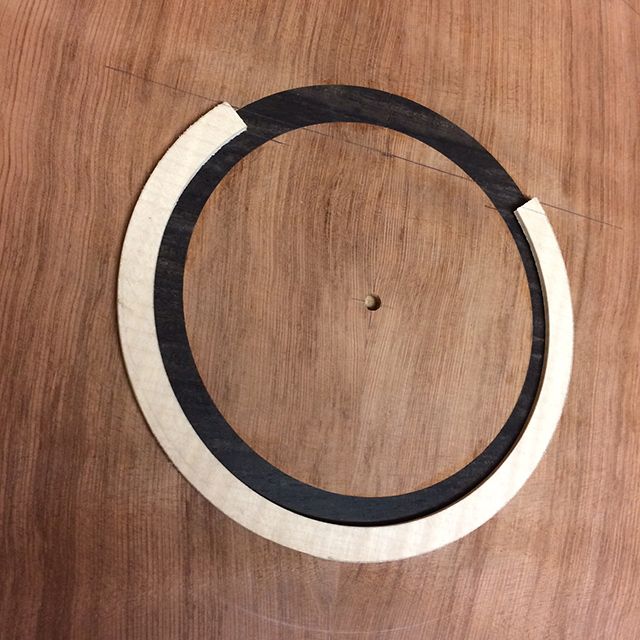 The channels are individually routed out and wood purfling surround strips are added in to the mix. The wood was inlayed 1.5mm into the wood which just left a little bit to scrape away to bring it flush with the soundboard. And here it is with the sound hole cut out too. It needs to be cleaned up and rounded on the outward side, but I’ll wait to do all that once the soundboard is at final thickness.  Moving on to the Ebony back now, which is ready to be braced. I use a cross brace method on my guitar backs and always select a hardwood to do this. I like the cross brace because I aim to achieve a ‘live back’ instead of a ‘rigid reflector’. Results of my previous builds using this method have shown it to do the job nicely. For this one I have chosen Padauk timber for the braces. Generally I look for a medium density hardwood for this bracing. I make the timber choice based on the colour, aesthetics, density of the back and importantly, what might compliment it when considering overall tone and timbre of the back. The 25ft radius for the back braces is shot with a plane and a shooting board. I inspect the braces whilst placed on the board in the radius dish before they go down to ensure I have a really nice clean fit. 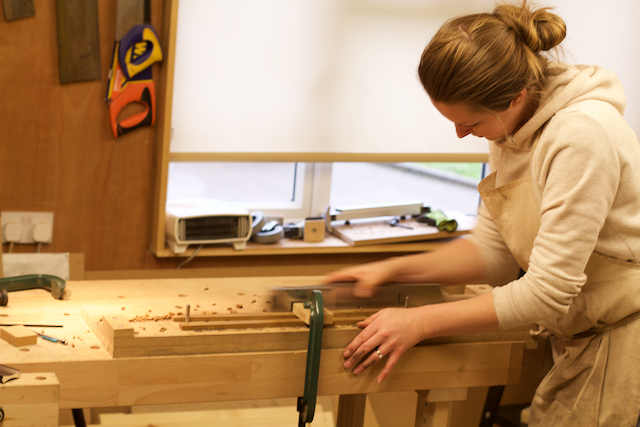 (Courtesy of my in-house photographer...aka my husband) Glue used to stick down the braces is Titebond, I've always got on well with it and it cleans up nicely. The braces are stuck down separately with the traditional Go-Bar method. 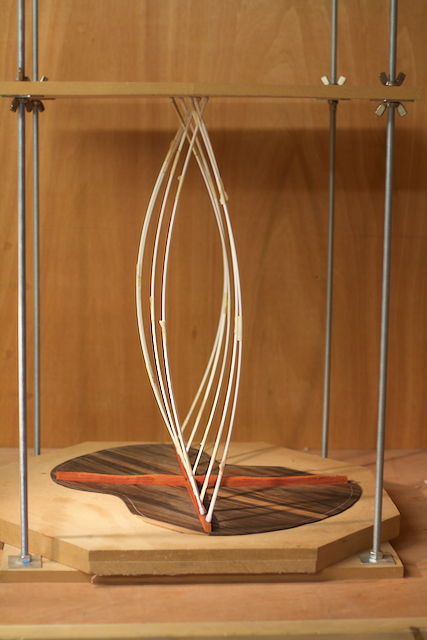 Once down, the braces are scalloped removing enough to bring out a responsive tap tone in the back but making sure you leave it strong enough to remain structurally sound. I'll have a completed pic for you next time.  In other news, the neck is making its debut appearance. It's a lovely piece of South American Mahogany and it was initially dimensioned and squared up with the ole faithful Veritas no 5 plane, and then scarf jointed at the headstock and block stacked at the heel. Here it is being glued up. 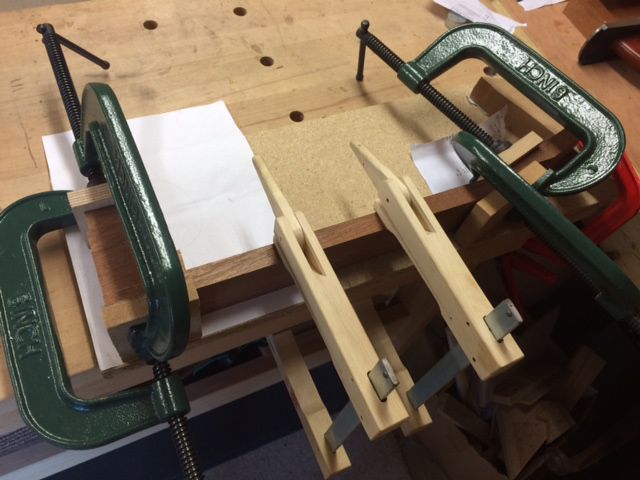 Hope you enjoyed the update and I'll be back soon with more! |
|
francis
C.O.G. 
Posts: 2,483  My main instrument is: Whatever I'm building...
My main instrument is: Whatever I'm building...
|
Post by francis on Feb 22, 2016 21:28:52 GMT
Rosie - I like the way you mocked the rosette up first. I use photoshop and a scanner to scan in the timbers and then do a virtual cut to shape and layer the scans twist and turn them until I get what I feel is right. See the Mandolin project I'm doing at the moment the first image is a mock-up in PS of the mandolin as I envisioned it...
Liking this thread very much
|
|
davewhite
Luthier / Guitar Maker
Luthier
Aemulor et ambitiosior
Posts: 3,548
|
Post by davewhite on Feb 23, 2016 8:59:36 GMT
Rosie, Great workmanship and great to see the maker at work  That's the first time I've seen hardwood - apart from mahogany - used for bracing, interesting. The padauk I have used is similar in density to the rosewoods. Are you using Padauk anywhere else on the guitar? The braces on the back stand a better chance of staying red inside the box rather than turning chestnut brown as padauk usually does over time when exposed to light. Looking forward to the rest of the build. |
|
|
|
Post by RosieTGC on Feb 23, 2016 11:43:05 GMT
Rosie - I like the way you mocked the rosette up first. I use photoshop and a scanner to scan in the timbers and then do a virtual cut to shape and layer the scans twist and turn them until I get what I feel is right. See the Mandolin project I'm doing at the moment the first image is a mock-up in PS of the mandolin as I envisioned it... Liking this thread very much Hi francis, that's a really cool idea to do that. It comes together really nicely as I can see in your thread. I can be hard to visualise it all so any tools to help before the full commitment is made are nice to have! |
|
|
|
Post by RosieTGC on Feb 23, 2016 11:53:51 GMT
Rosie, Great workmanship and great to see the maker at work  That's the first time I've seen hardwood - apart from mahogany - used for bracing, interesting. The padauk I have used is similar in density to the rosewoods. Are you using Padauk anywhere else on the guitar? The braces on the back stand a better chance of staying red inside the box rather than turning chestnut brown as padauk usually does over time when exposed to light. Looking forward to the rest of the build. Hi davewhite , Thanks for the comment! Yes I am also using Padauk on other parts, but on this guitar it will all be internal. So the tantilon pieces (similar to kerfing) that attach the sides to the top and back will also be Padauk and also the bracing on the treble side of my sound board will be Padauk too. This stash of timber I'm using feels a similar weight and density to other Mahogany I have. I've used Mahogany and Padauk on previous builds and even Oak on my all English series. They all seemed to have worked really nicely. And yes you're probably right about keeping it's colour more - I think it's an added little bonus to look in and see some really nice colour hidden away inside the soundbox.  |
|
|
|
Post by RosieTGC on Mar 3, 2016 20:53:28 GMT
Just a quick update on the build. The back bracing is now shaped and sanded along with the centre line stitches which have been added since last time - also made from Padauk. 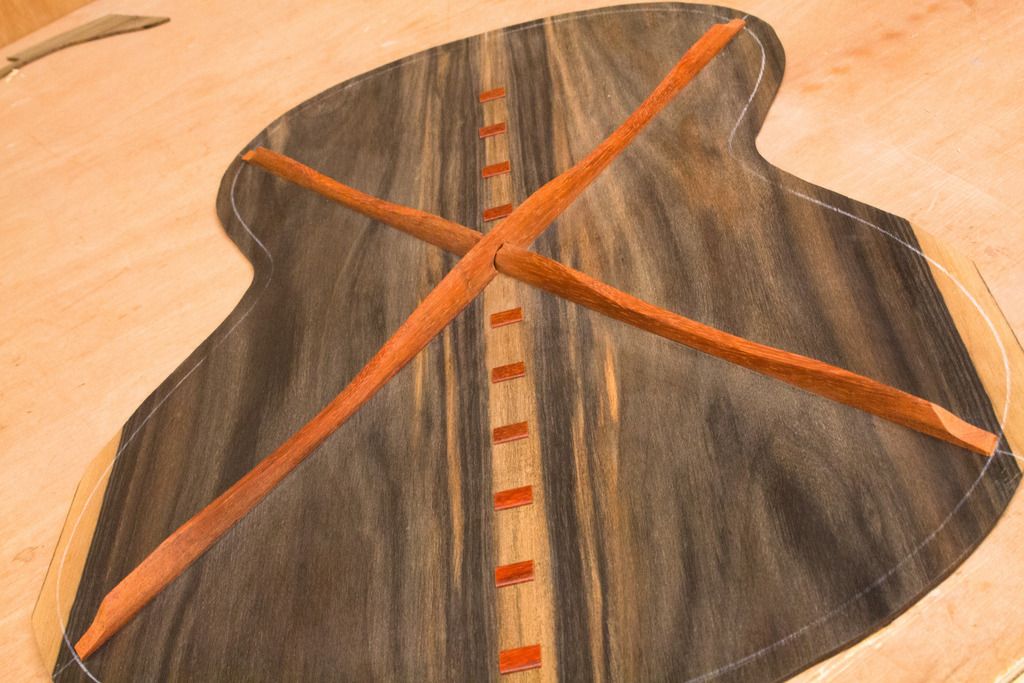 |
|
missclarktree
C.O.G. 
Posts: 2,429  My main instrument is: It varies
Mini-Profile Background: {"image":"","color":"1979e6"}
Mini-Profile Name Color: 100605
Mini-Profile Text Color: 020a12
My main instrument is: It varies
Mini-Profile Background: {"image":"","color":"1979e6"}
Mini-Profile Name Color: 100605
Mini-Profile Text Color: 020a12
|
Post by missclarktree on Mar 4, 2016 19:53:40 GMT
Enjoyed following your build so far. I liked you mentioning the names of your tools and glue.
|
|
R the F
Luthier / Guitar Maker
Posts: 1,135  My main instrument is: bandsaw
My main instrument is: bandsaw
|
Post by R the F on Mar 4, 2016 22:39:53 GMT
The colour and grain combinations you have inside your guitar are stunning. It actually reminds me of Van Gogh's bedroom or Cezanne's cardplayers for some reason! Are you sure that's a photo?
|
|
|
|
Post by earthbalm on Mar 5, 2016 9:01:31 GMT
Beautiful guitar back. I've always preferred ebony that isn't solid black but showed grain on fingerboards.
Taylor guitars has an interesting video on the subject of ebony.
|
|
|
|
Post by RosieTGC on Mar 14, 2016 13:35:02 GMT
That's such an interesting video earthbalm thanks so much for sending it through. It's great to see someone of such prominence getting behind this movement. It will help to promote the acceptability of it and hopefully it will start to trickle through to the buyers. Wood scarcity and sustainability in general is going to be a huge factor for my generation of makers and even more for the ones that follow. One of the things I personally love most about wood is its varied character. I can spend a lot longer gazing at wood of interesting colour and pattern, trying to make shapes and see things that catch my eye, rather than something completely uniform - where's the fun in that?! On a side note for anyone that is interested, there is a project called the Leonardo Guitar Research Project that conducted blind tests on players with tropical and non-tropical wood guitars - let's just say the results were very interesting! Check out their website for more info on what they're doing. |
|
|
|
Post by RosieTGC on Mar 14, 2016 13:41:07 GMT
The colour and grain combinations you have inside your guitar are stunning. It actually reminds me of Van Gogh's bedroom or Cezanne's cardplayers for some reason! Are you sure that's a photo? Haha yes quite sure! The only thing on my paint brushes these days is glue! |
|
|
|
Post by earthbalm on Mar 14, 2016 13:51:41 GMT
That's such an interesting video earthbalm thanks so much for sending it through. It's great to see someone of such prominence getting behind this movement. It will help to promote the acceptability of it and hopefully it will start to trickle through to the buyers. Wood scarcity and sustainability in general is going to be a huge factor for my generation of makers and even more for the ones that follow. One of the things I personally love most about wood is its varied character. I can spend a lot longer gazing at wood of interesting colour and pattern, trying to make shapes and see things that catch my eye, rather than something completely uniform - where's the fun in that?! On a side note for anyone that is interested, there is a project called the Leonardo Guitar Research Project that conducted blind tests on players with tropical and non-tropical wood guitars - let's just say the results were very interesting! Check out their website for more info on what they're doing. Thanks for the information RosieTGC . There's been fierce debates over the influence of tone woods on electric guitar sounds plastered over the interweb for the last few years. I suppose it's true that any tonal qualities that an electric guitar might possess gets blasted into insignificance after amp and foot pedal distortions are added. But, I also suspect that we're all more prone to influence and suggestion than we'd like to believe - I certainly am. My favourite wood for back and sides is walnut but if were really pushed as to why, I probably couldn't be clinical and specific in my reasoning or explanation. One of the reasons I'm enjoying this forum so much is because there are so many well-informed luthiers here. The availability of materials does worry me and when I see musical instrument shops lined with dozens of instruments I could cry - many seem to hang there for years and all of the production plants seem to keep churning them out. Apologies if I've said anything contentious. |
|
R the F
Luthier / Guitar Maker
Posts: 1,135  My main instrument is: bandsaw
My main instrument is: bandsaw
|
Post by R the F on Mar 15, 2016 23:23:33 GMT
A thought-provoker indeed, that video. You can't really disagree with him but I did feel that there was an even more logical conclusion; to wit, go one step further and save the ebony trees that are still growing - stripy or not - and use something else for your fingerboards. The Leonardo Project certainly seems to be suggesting that you can use any kind of tonewood and nobody would know the difference and, frankly, doesn't the fingerboard just need to be hard? Though I'm not sure how these comments fit in with my previous (rapturous) comments about the colours you've got going on inside this guitar.... Inconsistent, moi? Controversial, moi? French, moi?
|
|
|
|
Post by RosieTGC on Mar 20, 2016 18:11:08 GMT
A thought-provoker indeed, that video. You can't really disagree with him but I did feel that there was an even more logical conclusion; to wit, go one step further and save the ebony trees that are still growing - stripy or not - and use something else for your fingerboards. The Leonardo Project certainly seems to be suggesting that you can use any kind of tonewood and nobody would know the difference and, frankly, doesn't the fingerboard just need to be hard? Though I'm not sure how these comments fit in with my previous (rapturous) comments about the colours you've got going on inside this guitar.... Inconsistent, moi? Controversial, moi? French, moi? Haha yes I totally get where you're coming from. It's a very big topic of debate. Some people like the way that ebony feels, and some are just used to having it on their fingerboards. I've been using Bog Oak on some of my builds and it does a great job - people seem to really like it too when they try it. Maple is also a great fingerboard material. I think it's just about being open to experimentation, players may find something different that they really like! |
|
R the F
Luthier / Guitar Maker
Posts: 1,135  My main instrument is: bandsaw
My main instrument is: bandsaw
|
Post by R the F on Mar 20, 2016 19:00:37 GMT
Of course there's this stuff - which is only a bit more expensive than ebony! |
|

















 That's the first time I've seen hardwood - apart from mahogany - used for bracing, interesting. The padauk I have used is similar in density to the rosewoods. Are you using Padauk anywhere else on the guitar? The braces on the back stand a better chance of staying red inside the box rather than turning chestnut brown as padauk usually does over time when exposed to light.
That's the first time I've seen hardwood - apart from mahogany - used for bracing, interesting. The padauk I have used is similar in density to the rosewoods. Are you using Padauk anywhere else on the guitar? The braces on the back stand a better chance of staying red inside the box rather than turning chestnut brown as padauk usually does over time when exposed to light.

 Jo whoever he is.
Jo whoever he is.


